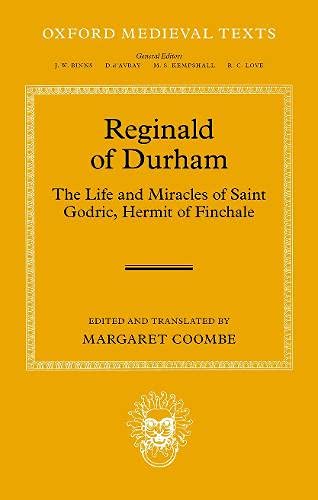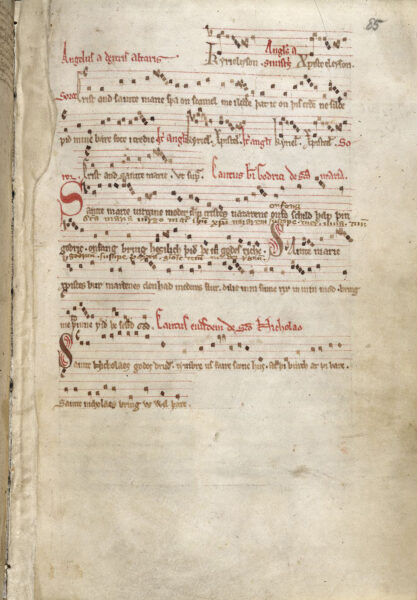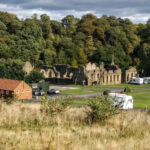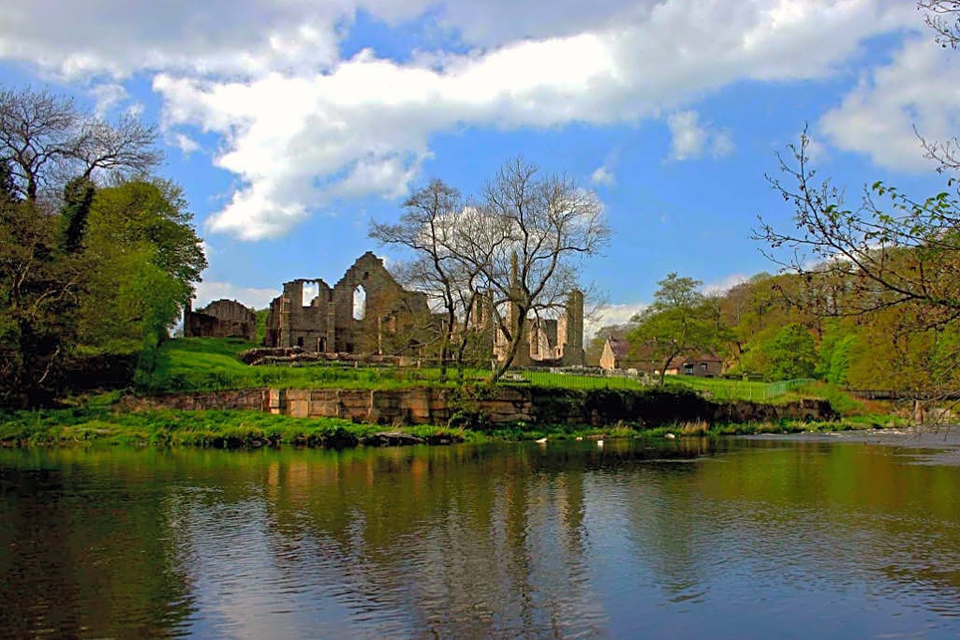Godrich of Finchale (1070-1170) was a popular saint in the county of Durham, where he ended his days as a hermit. A new edition and translation of his life has recently been published.
Reginald of Durham: The Life and Miracles of Saint Godric, Hermit of Finchale
by Margaret Coombe (Editor)
Series: Oxford Medieval Texts
Oxford University Press 2022
He was vigorous and strenuous in mind, whole of limb and strong in body. He was of middle stature, broad-shouldered and deep-chested, with a long face, grey eyes most clear and piercing, bushy brows, a broad forehead and open nostrils, a nose a comely curve, and a pointed chin. His beard was thick and longer than the ordinary, his mouth well-shaped, with lips of moderate thickness; in youth, his hair was black, in age as white as snow; his neck was short and thick, knotted with veins and sinews; his legs were somewhat slender, his instep high, his knees hardened and horny with frequent kneeling; his whole skin rough beyond the ordinary, until all this roughness was softened with old age.
From: Social Life in Britain from the Conquest to the reformation.
By G. G. Coulton. Cambridge University Press 1915, p. 415 ff (A Merchant Adventurer)
 Godric was the son of Ailward and Edwenna, and had an early career as a local pedlar. Later, he became a fullfledged merchant and shipman sailing on Denmark, Flanders and Scotland. This career lasted for 16 years, until he went on a pilgrimage to Jerusalem, from where he returned by way of Santiago de Compostella. After his return, Godric became a steward in a lord’s household “in his own country”, where he laboured to stop the the lord’s men from steeling the neighbours’ cattle and holding luxurious feasts. Not successful, Godric then departed on another pilgrimage to St. Gilles and later Rome, a feat later repeated together with his mother. At some point, he had a profound religious experience at Lindisfarne, which brought him to spend his last 40-60 years as a hermit and saint-in-spe at Finchvale near Durham.
Godric was the son of Ailward and Edwenna, and had an early career as a local pedlar. Later, he became a fullfledged merchant and shipman sailing on Denmark, Flanders and Scotland. This career lasted for 16 years, until he went on a pilgrimage to Jerusalem, from where he returned by way of Santiago de Compostella. After his return, Godric became a steward in a lord’s household “in his own country”, where he laboured to stop the the lord’s men from steeling the neighbours’ cattle and holding luxurious feasts. Not successful, Godric then departed on another pilgrimage to St. Gilles and later Rome, a feat later repeated together with his mother. At some point, he had a profound religious experience at Lindisfarne, which brought him to spend his last 40-60 years as a hermit and saint-in-spe at Finchvale near Durham.
Finchale is located a few miles downstream on the river Wear. His first hermitage was probably a few kilometers upriver from Finchale, but he soon moved to the present site where the ruins now stand.
According to Reginald, he built himself a hut with a turf roof, a chapelfitted with a crucifix, an image of the Virgin Mary, and a bell. His life as a hermit was ascetic. He often prayed immersed in the cold water of the river and his ascetic diet has garnered some fascination. He also wore a hair shirt and slept with a stone as a pillow.
His life was not totally solitary, as his mother, brother and sister all came to live nearby within a few years of his arrival. Several notable individuals are said to have asked for advice including Thomas Becket and Pope Alexander III, while King William the Lion of Scotland visited him in person.
Later in life Godric became bedridden and one or more of the Durham monks came to live with him. After seven years confined to hid bed, Godric died, aged around 100, on 21 May 1170. His burial place on the north side of the church is marked by a cross in the grass
Apparently, the religious community considered Godric a “rustic idiot” and an uncultured man, while at the same time revering him for his ascetism and spirituality. Never formally canonised, Godrich was nontheless recognised and venerated in his afterlife as an important local saint.
Several hagiographers gave accounts of his life. Already, in the saint’s lifetime, Germanus – prior to Durham – wrote a life based on his intimate knowledge of the saint. It was Germanus, who had allowed Godrich to spend his last years at Finchale. Later, Geoffrey of Durham wrote another Life, finished in 1196 and based on the recollections of Germanus and Reginald. The prize, however, goes to Reginald of Durham († c. 1190), who wrote a substantial “life” based on his own vivid recollections and conversations with the saint. This vita was based on the visits, which Reginald undertook to Finchvale, to hear about the saint’s life from his own mouth. But also Reginald’s observations, and particulars furnished by other members of the community contributed to his lively and detailed biography.

Past research on Godric of Finchdale has been based on summaries or epitomes of Reginald’s work. However, it is now clear that several authors rewrote the story to omit many miracles and large potions of the text; only one manuscript remains a testament to the original.
The new edition is the first full, literal translation, presenting Reginald’s work as closely as possible to the single original manuscript. As such, it provides a long and intimate account of the life of a merchant, pilgrim and hermit. Although the contemporary audience for Reginald’s story was probably small, provincial and local, one of the charms of the life written by Reginald is the many details of daily life – in and out of Durham – which the text offers. The new edition and translation will surely open up the work to a wider audience.
The vita has been heavily mined by economic and cultural historians since the beginning of the 20th century. Apart from the valuable insight it provides of the organisation of medieval trading in the 12th century, the vita also offers a liturgical and musical background for the four songs written by Godric of Finchale, arguably the earliest songs written in the English language to survive with musical notations. However, other cultural historical perspectives will surely present themselves.
ABOUT THE AUTHOR:
Margaret Coombe is Director of Study Skills at Lady Margaret Hall, Oxford. Following from undergraduate degrees in History and French, and postgraduate in Art History and Classics, Margaret returned to Oxford in 2005 to undertake her D.Phil. as a mature student in History. She was subsequently acting Senior Tutor, and since 2018 she has been Director of Study Skills at the Oxford Study Skills Centre at Lady Margaret Hal
The edition and translation by Margaret Coombe is a by-product of her PhD thesis from Oxford 2011.
READ MORE:
The novel “Godric” (1981) by Frederick Buechner is a fictional retelling of his life and travels. It was nominated for a Pulitzer Prize.”
HEAR MORE:
Crist and Sainte Marie by Saint Godric of Finchale (1065-1170) is one of the oldest known surviving songs using the English language (although parts are in Latin).
Only four songs by the mystic and hermit Saint Godric survive, with the surviving manuscript (from a little later) shown in this film-clip. Also pictured is a representation of the Saint himself, and a photo of the ruins of the priory at Finchale where he died, aged 105.
This is a live performance by Lumina Vocal Ensemble. Singers are Saam Thorne (solo), Rachel Sag and Michele de Courcy. Musical Director Anna Pope and vocal coach Professor Tom Burton.
VISIT:
Some 25 years after Godric’s death, the hermitage was turned into a priory. By the mid-14th century this was serving as a holiday home for monks from Finchale’s parent monastery, Durham.
Today, Finchale Priory is in ruins, but offer a beautiful avenue for a day out from Durham.
 Next to Finchale Priory, Finchale Abbey Touring Park is located. A nice place to stay while exploring the sourroundings, the river Wear and Durham.
Next to Finchale Priory, Finchale Abbey Touring Park is located. A nice place to stay while exploring the sourroundings, the river Wear and Durham.


